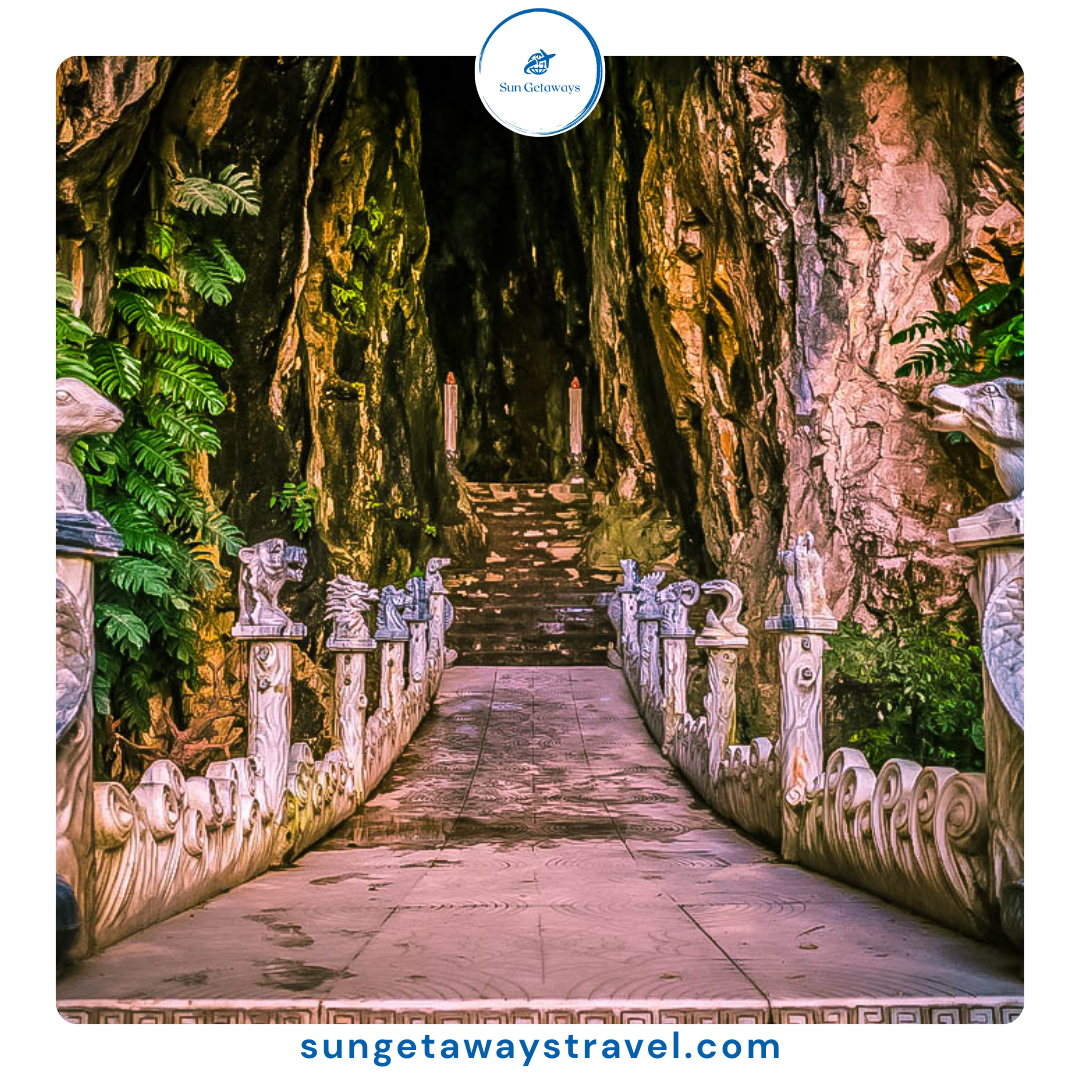Marble Mountains Danang Guide: Temples, Caves, and Views
If you’re planning a trip to Central Vietnam, one destination you simply cannot miss is the Marble Mountains Danang. Rising dramatically from the coastal plains, these five limestone and marble hills are not only natural wonders but also spiritual sanctuaries, cultural landmarks, and perfect viewpoints over the city and the sea. For travelers who love a blend of history, nature, and adventure, the Marble Mountains are the ideal stop during your Da Nang or Hoi An itinerary.
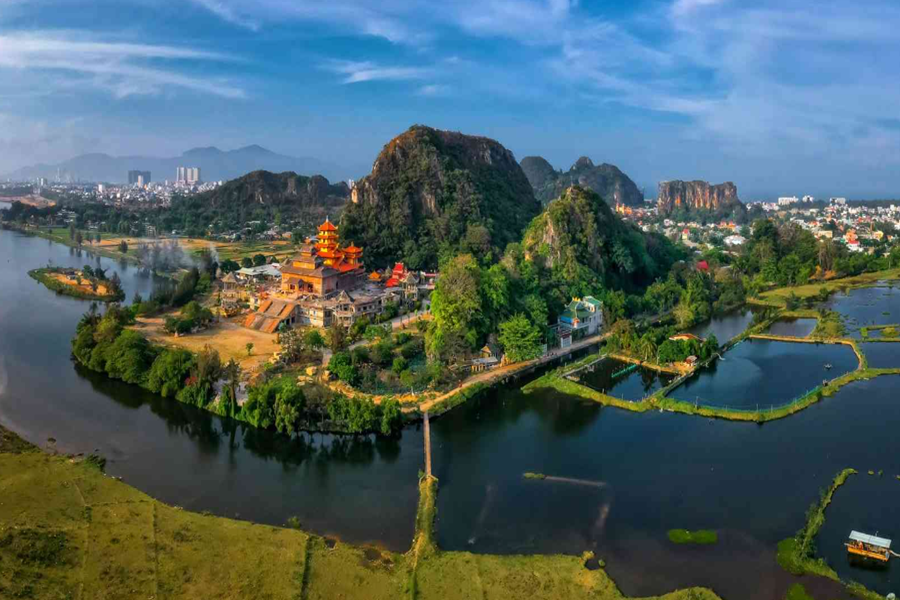

In this guide, we’ll take you through everything you need to know about the Marble Mountains Danang—their history, caves, temples, viewpoints, and practical travel tips. Whether you’re visiting for a few hours or dedicating a day, this comprehensive guide ensures you’ll make the most of your trip.
A Brief History of Marble Mountains Danang
The Marble Mountains Danang (Ngũ Hành Sơn in Vietnamese, meaning “Five Elements Mountains”) are a cluster of five hills named after the elements: metal, wood, water, fire, and earth. Formed millions of years ago, these karst outcrops have become iconic landmarks of Da Nang, located just a short drive south of the city center.


Throughout history, the Da Nang mountains have held deep spiritual significance. They are dotted with ancient pagodas, shrines, and Buddhist sanctuaries that draw both pilgrims and tourists. During the Cham civilization, the mountains were sacred places for Hindu and Buddhist worship. Later, under Vietnamese influence, temples and grottoes were added, blending religious traditions.
Interestingly, during the Vietnam War, the caves of the Marble Mountains were used as hiding spots and field hospitals by the Viet Cong, giving them a fascinating historical edge.
✨ Travel tip: To discover these hidden stories in depth, consider booking a guided experience with Sun Getaways Travel, where our expert guides reveal the history and legends behind each temple and cave.
Exploring the Five Mountains
Although the cluster consists of five mountains, the most accessible and frequently visited is Thuy Son (Water Mountain). Here’s an overview of what each mountain represents:


- Thuy Son (Water Mountain): The largest and most popular, home to many caves, pagodas, and viewpoints.
- Moc Son (Wood Mountain): Mostly barren, known for its striking white marble formation resembling a sitting Buddha.
- Hoa Son (Fire Mountain): Consists of two peaks, with caves and shrines nestled inside.
- Kim Son (Metal Mountain): Features a mysterious cave with Cham sculptures.
- Tho Son (Earth Mountain): Known for its tunnels and wartime history.
Most travelers focus their visit on Thuy Son, where the highlights of the Marble Mountains are concentrated.
Highlights of Marble Mountains Danang
1. The Caves
The caves in the Marble Mountains are mystical, each with unique legends and religious significance.
- Huyen Khong Cave: The most famous, with shafts of sunlight filtering through the roof, creating a surreal, spiritual atmosphere. Inside, you’ll find Buddhist statues and altars.
- Am Phu Cave (Hell Cave): A darker, atmospheric cave symbolizing the Buddhist concept of heaven and hell. Sculptures depict scenes of punishment and redemption.
- Tang Chon Cave: Smaller but equally fascinating, with hidden shrines tucked away inside.
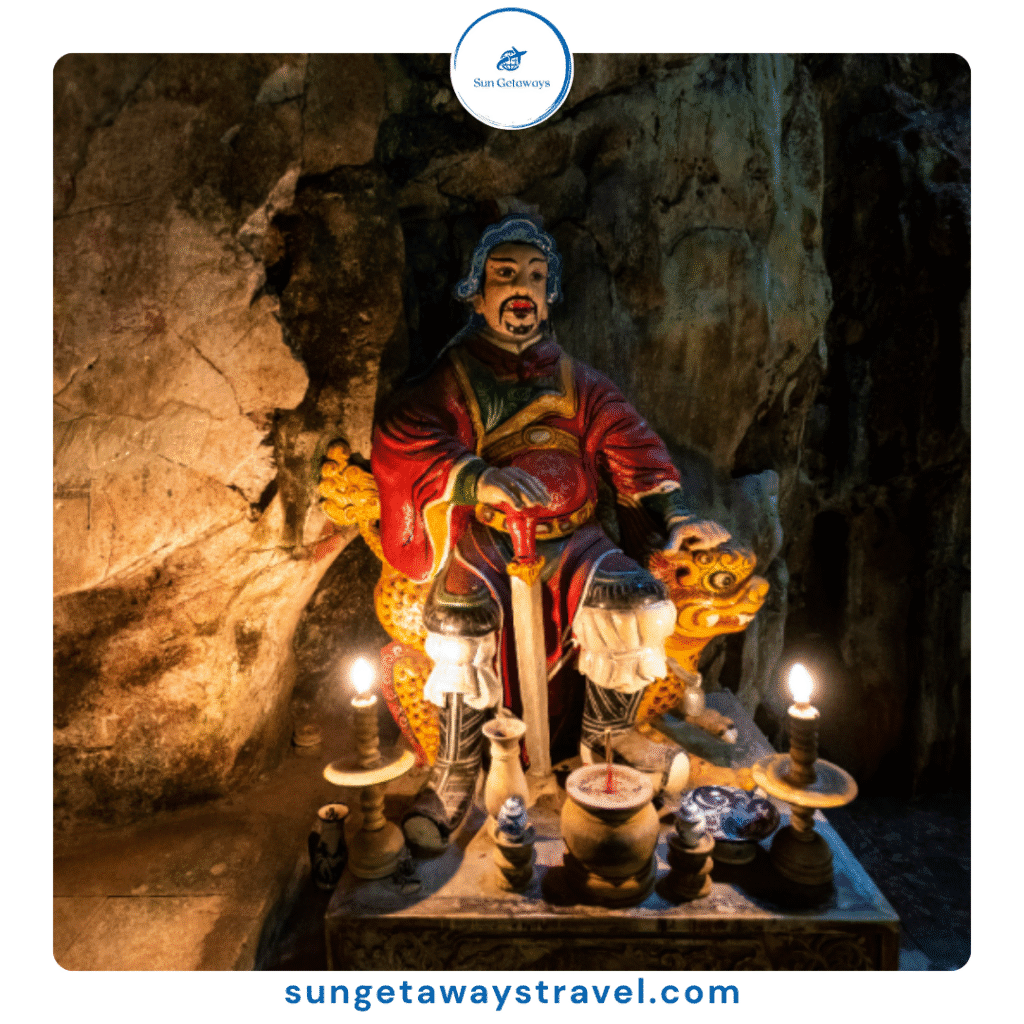

Exploring these caves feels like stepping into another world, blending spirituality, mythology, and natural beauty.
2. The Pagodas
Scattered across the Da Nang mountains are several Buddhist temples and pagodas, each offering tranquility and history.
- Linh Ung Pagoda: The most renowned temple on Thuy Son, with its elegant architecture and peaceful courtyards.
- Tam Thai Pagoda: Built in the 17th century, this temple stands as a symbol of Da Nang’s religious heritage.
- Xa Loi Tower: A striking seven-story tower dedicated to Buddha’s teachings.


These pagodas provide not only a spiritual retreat but also stunning architectural details worth photographing.
3. Viewpoints
Climbing to the top of Thuy Son rewards visitors with breathtaking panoramic views of Da Nang city, the coastline, and the lush countryside. On clear days, you can see the Cham Islands in the distance.
Whether you ascend by foot (via stone steps) or take the elevator recently installed for easier access, the views from the summit are unforgettable.
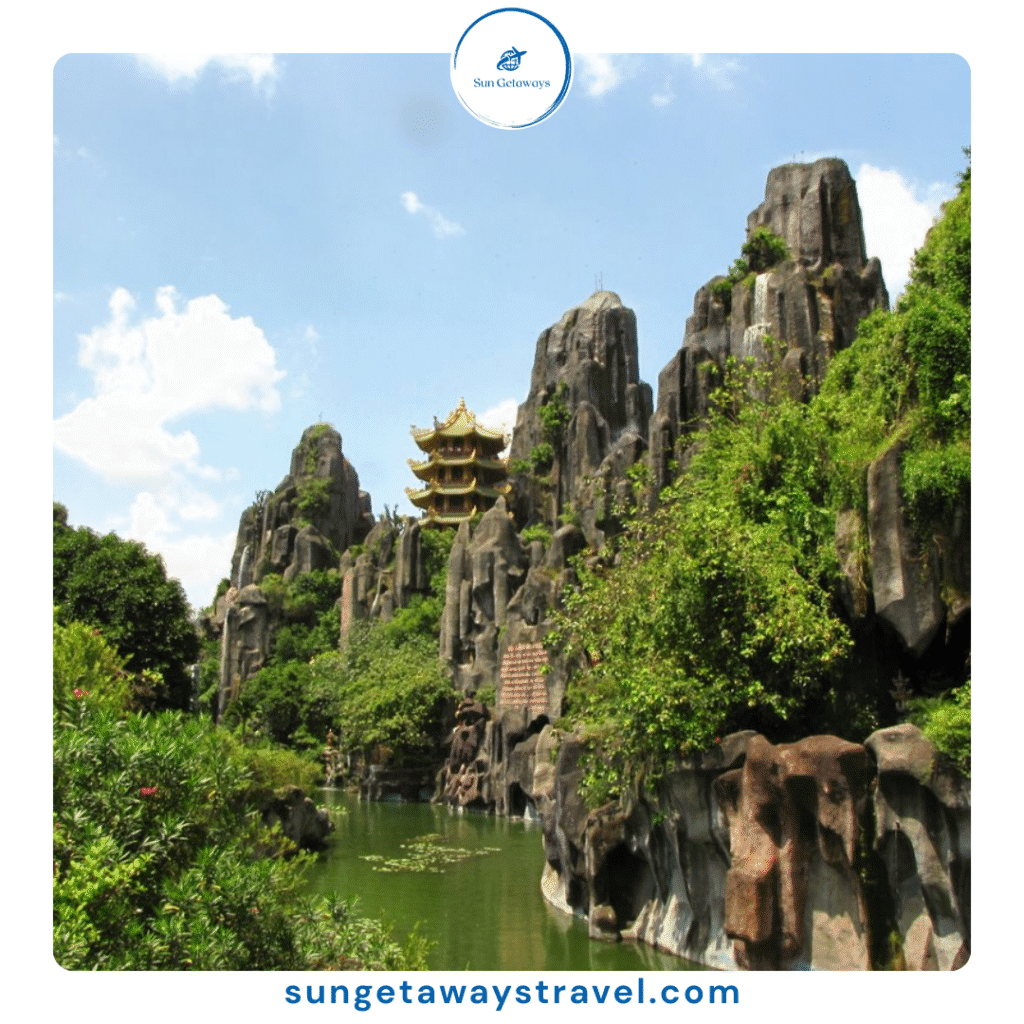

🌄 Want the best photos and hassle-free exploration? Join a Sun Getaways Travel half-day Marble Mountains tour in Da Nang, including hidden viewpoints only locals know about.
How to Visit Marble Mountains Danang
Location
The Marble Mountains Danang are located about 10 km south of Da Nang city center and 20 km north of Hoi An, making them an easy stop between the two popular destinations.


Getting There
- By motorbike: The most flexible option if you’re comfortable driving in Vietnam.
- By taxi: Convenient and affordable, especially if you’re traveling in a group.
- By guided tour: The most informative option, combining transportation with cultural insights.
Entrance Fees
- General entrance ticket (to Thuy Son): ~40,000 VND
- Elevator ride: ~15,000 VND one way
- Am Phu Cave entrance: ~20,000 VND
Prices may change slightly, but they remain very affordable (traveling Vietnam on a budget).
Best Time to Visit Marble Mountains Danang
The Marble Mountains can be visited year-round, but the best time is during the dry season (February to August), when the skies are clear, and the humidity is lower. Morning or late afternoon visits are ideal to avoid midday heat.
If you want to enjoy peaceful exploration, arrive early before the tourist buses. Sunset from the viewpoints is another magical experience not to miss.
Tips for Visiting Marble Mountains Danang
To ensure a smooth, enjoyable, and safe visit to Marble Mountains Danang, keep these practical tips in mind:
- Wear Appropriate Footwear: This is the most important tip. You will be climbing hundreds of uneven, steep steps and navigating slippery cave floors. Skip the sandals and wear sturdy, comfortable closed-toe shoes.
- Hydrate and Protect: Bring plenty of water, especially during the summer (March–August). The heat and climbing can be exhausting. Also, use sunscreen and wear a hat, as much of the climbing path is exposed to direct sunlight.
- Respect the Spiritual Sites: Remember that Marble Mountains is an active religious site. When entering pagodas or sacred cave areas, dress modestly—cover your shoulders and knees—as a sign of respect.
- Plan Your Time Wisely: Allocate at least 2 to 3 hours for your visit to fully explore the numerous pagodas and the main caves on Thuy Son (Water Mountain). Rushing will make the steep climb much harder.
- Consider the Elevator: If you have mobility issues or want to save energy for the caves, take the glass elevator up the mountain. It costs a small fee but offers scenic views and reduces climbing time significantly.
- Watch Your Belongings: Like any major tourist site, be aware of your surroundings and keep your valuable belongings secure to prevent pickpocketing.


Combining Marble Mountains with Other Attractions
The Marble Mountains Danang are conveniently located near other attractions, making it easy to plan a full-day trip.
- Non Nuoc Beach: Just a short walk away, this stretch of white sand is perfect for relaxing after exploring. You can even enjoy a great beach vacation here.
- Da Nang city highlights: Dragon Bridge, Han River cruises, and local markets. Afterwards, enjoy the exciting Da Nang nightlife scene.
- Hoi An Ancient Town: Only 30 minutes away, ideal for combining cultural exploration with beach time.
🚐 At Sun Getaways Travel, we specialize in creating custom itineraries combining the Marble Mountains, Hoi An, and Da Nang highlights, so you can maximize your time without the stress of planning.


Why the Marble Mountains Danang Should Be on Your Itinerary
The Marble Mountains Danang are more than just a set of hills—they are living museums of Vietnamese culture, religion, and history. From the dramatic caves and serene temples to the sweeping coastal views, every step through these mountains tells a story.
Whether you’re a spiritual traveler, a history buff, or a casual explorer, the Marble Mountains offer something unique and unforgettable.
And with their convenient location between Da Nang and Hoi An, they’re an essential stop on any Central Vietnam journey.
Final Thoughts
Visiting the Marble Mountains Danang is like stepping into a world where nature, spirituality, and history intertwine. Spend a few hours wandering through the caves, climbing to the viewpoints, and admiring the ancient temples—you’ll leave with not just photos, but lasting memories.
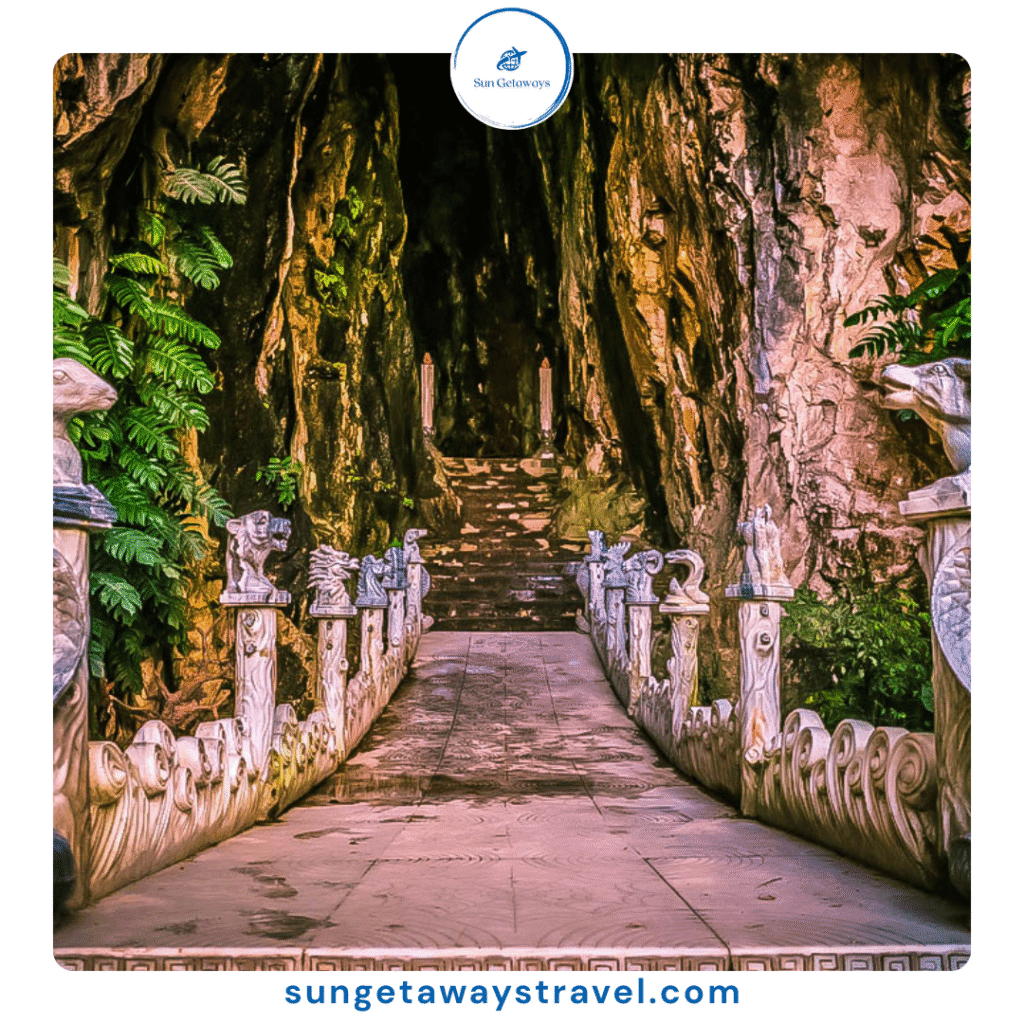

🌟 Ready to explore Marble Mountains and more? Contact Sun Getaways Travel (WhatsApp) today to plan your seamless Da Nang and Hoi An adventure. Our team ensures you don’t just visit Vietnam—you experience it to the fullest.
FAQs: Marble Mountains Danang
- Is there an entrance fee to Marble Mountains?
Yes, there is a small entrance fee to access the main mountain (Thuy Son), plus a separate fee if you choose to take the elevator instead of the stairs. - How much time should I set aside for the visit?
Plan to spend 2 to 3 hours to fully explore the pagodas, caves, and viewing platforms on Thuy Son (Water Mountain). - Are the caves difficult to access?
The main paths are well-maintained, but accessing some caves requires navigating steep, uneven, and sometimes slippery stairs. Wear appropriate footwear. - Which is the best mountain to visit?
Thuy Son (Water Mountain) is the only mountain developed for tourists and contains most of the famous caves, pagodas, and viewpoints. - Is it better to go in the morning or afternoon?
Early morning is highly recommended to beat the intense heat, avoid the largest crowds, and find the best light for photography inside the caves.
Ask a question
Leave a Comment (0)
No questions yet. Be the first to ask a question!









